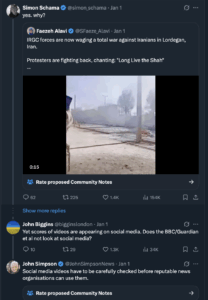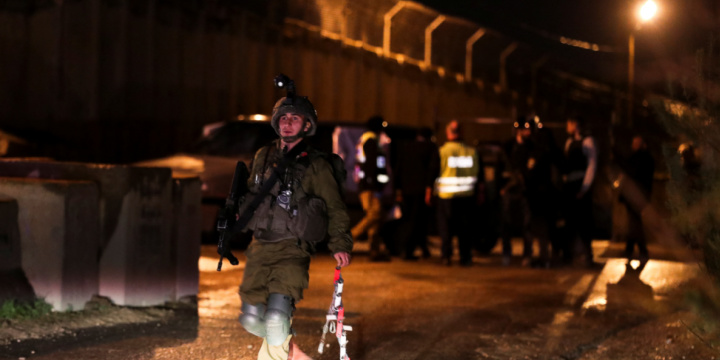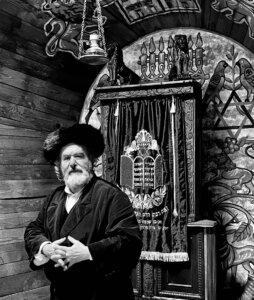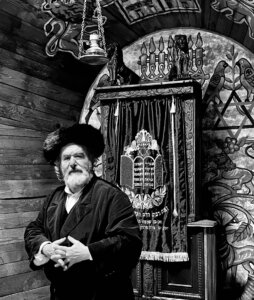Uncategorized
DC’s new Jewish museum highlights Jews who shaped the nation’s capital, from a Confederate spy to RBG
WASHINGTON (JTA) – Washington, D.C.’s new Jewish museum features at least two notorious women from history.
One is Ruth Bader Ginsburg, the first Jewish woman to serve as a Supreme Court justice, who was dubbed “Notorious RBG” late in her life by a cluster of fans. When the Capital Jewish Museum opens next week, it will launch with Ginsburg at its center when a traveling exhibit on her life has its final stop here.
The other is the 19th-century figure Eugenia Levy Phillips, whom the museum characterizes as “notorious” without irony.
“One of DC’s most notorious Confederate sympathizers, Eugenia Levy Phillips (1891-1902) came to town in 1853 with her congressman husband, Philip Phillips (1807-1884) of Alabama,” one of the exhibits says. “Eugenia, a spy, delivered Union military plans and maps to Confederate President Jefferson Davis.”
Another description of Levy Phillips in the museum is more straightforward: “SPIED for the CONFEDERACY,” it says below her photo.
An exhibit on Ruth Bader Ginsburg at the new Capital Jewish Museum in Washington D.C.;, June 1, 2023. (Ron Sachs/Consolidated News Photos)
The late justice and spy are two of an assemblage of notable Jews throughout history who grace the Capital Museum, which opens next Friday in northwest Washington’s Judiciary Square neighborhood, which was a local center of Jewish life more than a century ago. Showcasing the warts-and-all history of Jews in and around the nation’s capital — both prominent officials and ordinary denizens of the city — is the point of the museum, its directors say.
“Jews are a Talmudic people, we like to argue, we like to look at different sides of a story,” Ivy Barsky, the museum’s interim executive director, said Thursday at a tour for members of the media. Sarah Leavitt, the museum curator, involved the Jewish idea of “makhloket l’shem shamayim,” Hebrew for “an argument for the sake of heaven” — in other words, for sacred purposes.
“We’re telling the story in this museum in a Jewish way,” Leavitt said. “So that it’s not just that we might not agree, but actually the disagreement is important and preserving those disagreements is important.”
Barsky, who was previously the CEO of the National Museum of American Jewish History in Philadelphia, said that in relating the local history of Washington’s Jews, the new museum fills a gap. Unlike many of the country’s other longstanding Jewish communities, Washington attracted Jews not because it was a port but because it was the center of government. Like the district’s broader community, Jews in the area have been prone to transitioning in and out of the city.
“Lots of our stories start in other places, with folks who end up in D.C.,” Barsky said. “This is a unique community, especially because the local business is the federal government.”
An exhibit at the new Capital Jewish Museum asks visitors, “Who are you? and features a diverse array of Jews , in Washington D.C., June 1, 2023. (Ron Sachs/Consolidated News Photos)
Jews have been in Washington since it was established in 1790, and the area now includes some 300,000 Jews, according to a 2017 study. The museum chronicles that community’s expansion from the capital to the Maryland and the Virginia suburbs, driven at times by Jews joining “white flight” — when white residents left newly integrated neighborhoods — and other times by restrictions that barred Jews from certain areas.
Larger historical events have also at times played a role: The Jewish population in the city grew in the 1930s and 1940s because of the expansion of government during President Franklin Delano Roosevelt’s New Deal and World War II.
An exhibition asks visitors “Who are you?” and features a diverse range of Washington Jews, past and present, as well as others with quirky biographies, including Tom King, a CIA spy who became a comic book writer.
The changing fortunes of American Jewry are embedded in the date the museum opens, June 9: On that date in 1876, Ulysses Grant was the first president to attend synagogue services, when he helped dedicate the new building of the Adas Israel congregation. Fourteen years earlier, as a Union general, he infamously expelled the Jews of Paducah, Kentucky, accusing them of being war speculators. President Abraham Lincoln rescinded the order, which has been described as “the most sweeping anti-Jewish regulation in all of American history,”
Esther Safran Foer, the museum’s president and the former executive director of the city’s historic Sixth & I synagogue, said Grant’s presence in 1876 in the Adas Israel building was emblematic of the upward trajectory of American Jewry. “He sat here for more than three hours in the heat, no air conditioning, and he even made a generous personal contribution,” she said.
The museum’s core is the 1876 building that Grant helped dedicate. It has since been physically moved in its entirety three times in order to preserve it, most recently in 2019 as part of the initiative to build the museum, which began in 2017. The museum’s upper floor reproduces the sanctuary, with the original pews. Its walls, however, are renovated: they display an audiovisual chronicle of the area’s Jews.
The museum’s permanent exhibition aims to traverse that history in other engaging ways as well. The same section that highlights Levy Phillips’ adventures (including her diary’s account of her arrest — “I am not in the least surprised Sir” she told the agent who had come to take her away) also mentions Rabbi Jacob Frankel, who was commissioned by Lincoln during the Civil War as the first Jewish military chaplain.
A photo of Jews and Blacks joined in a bid to desegregate a local amusement park in the early 1960s gets equal billing with one of Sam Eig, a Jewish developer who in 1942 advertised the new Maryland suburb he built as “ideally located and sensibly restricted,” a euphemism for not allowing Black people to buy property.
Interactive exhibits include a Seder table that encourages guests to debate immigration, Israel and civil rights. Parts of the museum’s exhibition recount Jewish debates over pivotal issues such as those and others, including abortion.
Ginsburg will be the museum’s first main attraction, and it makes clear she was a role model. The special exhibition on her life and career includes a glamorous photo of the two Jewish women who coined the “Notorious RBG” nickname, Shana Knizhnik and Irin Carmon. Visitors can go into a closet and don duplicates of Ginsburg’s judicial robes.
One of the first events is on July 12, when museum goers will join in fashioning the special “I Dissent” collars that Ginsburg would famously wear over her robes when she was ready to dissent from the bench.
Jonathan Edelman, the museum’s collections curator, described one prized collection — items he persuaded disability rights advocate Judy Heumann to donate before she died in March.
“Judy’s is a Washington story,” he said. “She came to this city first as an outsider as a protester protesting for disability rights. And then she came back to the city as an insider working within the government to make change both in D.C. government and in the federal government.”
—
The post DC’s new Jewish museum highlights Jews who shaped the nation’s capital, from a Confederate spy to RBG appeared first on Jewish Telegraphic Agency.
Uncategorized
The Iranian People Are Demanding Their Freedom; Where Is the Media?

Protesters demonstrate against poor economic conditions in Tehran, Iran, with some shopkeepers closing their stores on Dec. 29, 2025, in response to ongoing hardships and fluctuations in the national currency. Photo: ZUMA Press Wire via Reuters Connect
“What were the media doing when the regime led by Ali Khamenei finally fell?”
That is the question that will be asked if, as many Iranians now dare to hope, we are witnessing the final days of the Islamic Republic after more than four decades in power. It is also a question the Western press may struggle to answer.
How It Started
The current wave of unrest began in late December, when shopkeepers in Tehran went on strike amid growing fury over Iran’s collapsing economy. The rial hit record lows, while prices continued to soar under crippling inflation. Traders, wholesalers, and merchants took to the streets in protest, initially over economic mismanagement — but anger quickly turned toward the regime itself.
Within 48 hours, demonstrations had spread beyond the capital to major cities including Isfahan, Shiraz, Mashhad, Hamadan, Qeshm, and beyond. Videos posted by Iranians showed crowds chanting explicitly political slogans: “Death to the dictator,” “Mullahs must go,” and “This homeland will not be free until the mullah is gone.”
Iranian state-affiliated media have acknowledged several deaths. Independent estimates suggest the toll may be significantly higher. What is not in dispute is that the unrest has rapidly evolved from economic protest into a broad-based challenge to clerical rule.
The Story the Media Barely Told
And yet, on Friday, The New York Times ran not a single front-page story on the protests.
Not one.
This was unrest that — if it succeeds — could reshape Iran, the Middle East, and global security dynamics for decades. A regime that backs Hamas and Hezbollah, arms terrorist proxies across the region, threatens Israel’s destruction, and destabilizes international energy markets was facing its most sustained nationwide dissent in years. Still, the story barely registered.
The New York Times’ near silence was not an outlier. It was emblematic.
When the lack of coverage was challenged on social media, John Simpson, World Affairs Editor at the BBC, offered an almost comical defense: social media videos, he said, must be carefully verified before “reputable outlets” can use them.

That principle, in isolation, is uncontroversial. But its selective application is not.
This is the same BBC that has repeatedly broadcast unverified — or lightly verified — footage and photographs from Gaza. In Iran, however, verification suddenly became an insurmountable obstacle, even as dozens of videos from multiple cities showed consistent scenes, slogans, and patterns of unrest.
When Framing Does the Regime’s Work
Reports by the BBC and analyses from BBC Verify have repeatedly emphasized “cost-of-living protests,” despite verified footage of crowds chanting for the end of clerical rule and attacking regime symbols.
Where BBC Verify has undertaken the “verification” John Simpson said was so difficult, it has drawn criticism for focusing on debunking isolated instances of AI-generated imagery — rather than acknowledging the overwhelming volume of genuine footage documenting brutality against protesters.
Genuinely shocked to see BBC Verify have chosen now to be out there giving an impression we should not believe what we are seeing in #Iran based on one image (of a real event).
Amplification of this intensely organic revolution by Israeli social media accounts is making many…
— Omid Djalili (@omid9) January 2, 2026
Sky News, Reuters, FRANCE24, and others followed a similar pattern — leading with rising prices and economic stagnation while giving little attention to the unmistakably political slogans echoing through Iranian streets.
This framing matters. Protests about inflation suggest reform. Protests calling for the removal of the Supreme Leader suggest regime collapse.
In some cases, Western coverage has gone further, adopting the regime’s preferred framing outright.
When President Donald Trump warned that the United States would respond if Iranian protesters were massacred, Iranian officials condemned the remarks as “reckless.” Several outlets, including the BBC, led with that condemnation, centering Tehran’s outrage and implicitly casting the United States, rather than the Islamic Republic, as the destabilizing force.
Last week, The Guardian even published an opinion piece by Iran’s foreign minister, Abbas Araghchi, under the headline: “You’ll never defeat us in Iran, President Trump: but with real talks, we can both win.”

Put simply, this was The Guardian lending its pages to the propaganda of a senior official from the very regime Iranians are risking their lives to oppose — the same Islamic Republic that beat Mahsa Amini to death for allegedly wearing her hijab incorrectly, executed protesters, imprisoned dissidents, and ruled through fear for 45 years.
1/
Western media coverage of Iran’s escalating nationwide protests has been strikingly limited and cautious – despite widespread anti-regime demands across dozens of cities.Why the reluctance, when evidence is abundant?
pic.twitter.com/PWF9hgsdI3
— HonestReporting (@HonestReporting) January 3, 2026
So Why Is the Media Reporting This Way?
Western journalists do not lack information about Iran. The evidence is abundant and often supplied at immense personal risk by Iranians themselves.
What appears lacking is not access, but editorial willingness.
Acknowledging an evolving anti-regime uprising would force uncomfortable conclusions: that long-standing assumptions about “stability,” “reform,” and diplomatic engagement with Tehran were misplaced; that the Islamic Republic is not merely flawed but fundamentally illegitimate; and that Western governments and institutions have spent decades accommodating a brutal regime now being openly rejected by its own people.
It is easier — safer — to frame unrest as economic grievance, to hide behind verification rhetoric, or to platform regime voices as “context.”
But if this uprising succeeds, history will not be kind to that caution. And the question will remain: When Iranians were demanding freedom, why did so much of the Western media look away?
The author is a contributor to HonestReporting, a Jerusalem-based media watchdog with a focus on antisemitism and anti-Israel bias — where a version of this article first appeared.
Uncategorized
Palestinian Authority Police Commit Another Terrorist Attack

Illustrative: Israeli forces gather at the scene of a shooting attack near a Jewish outpost, near Nablus, in the West Bank, December 16, 2021. REUTERS/Ammar Awad
When Palestinian Authority (PA) police officer and Fatah’s Al-Aqsa Martyrs’ Brigades terror-wing member Younes Walid Shtayyeh shot at Israeli special forces and wounded an Israeli soldier near Nablus, it was not cause for self-scrutiny on behalf of the PA police.
On the contrary, two days later, PA Police Commissioner Allam Al-Saqqa elaborated on the “professional police establishment, which acts as a law enforcement body.” He stressed that the PA police force “maintains security, public order, and morality,” a message the official PA TV reporter summarized by claiming the PA police are “loyal … to the law:”
PA Police Commissioner Allam Al-Saqqa: “[Our progress] emphasizes the integrative relationship between the State Prosecutor’s Office and the [PA] Police, through participation in enforcing justice in the criminal field, which is being protected by a skilled State Prosecutor’s Office that is striving to strengthen the rule of law, alongside a professional police establishment, which acts as a law enforcement body, operates in coordination with the State Prosecutor’s Office and under its supervision, maintains security, public order and morality, and fulfills its role within the framework of the law” … [emphasis added]
[Official PA TV News, Nov. 22, 2025]
According to PA ideology, there really is no contradiction between trying to murder Israelis and maintaining the law. Fatah and Hamas alike glorified the “operation” of police terrorist Shtayyeh, and after he was killed by Israeli forces, social media overflowed with praise for him.
Palestinian Media Watch has documented the double role of the PA police and Security Forces as cops by day — and terrorists by night — many times, recently in the report, Terrorists in Uniform.
Fatah’s terror wing announced with “pride and glory” that Shtayyeh’s funeral was a “wedding” and stressed that the PA police officer died while “fulfilling the duty of struggle and engaging in armed confrontation with enemy.”
The Al-Aqsa Martyrs’ Brigades also used the opportunity to pledge to continue “the path of struggle” until “the removal” of the State of Israel:
Posted text: “A military statement by the Al-Aqsa Martyrs’ Brigades
…
Martyr fighter Younes Walid Shtayyeh — one of the fighters of the Al-Aqsa [Martyrs’] Brigades — Nablus
Who ascended to Heaven as a Martyr on Friday, Nov. 21, 2025 … while he was fulfilling the duty of struggle and engaging in armed confrontation with enemy …
The Al-Aqsa Martyrs’ Brigades, while accompanying the Martyr commander to the wedding, pledge before Allah that their fighters will continue … on the path of struggle and resistance, until the removal of the occupation from our land and our occupied holy sites.This is a revolution until victory!
The Al-Aqsa Martyrs’ Brigades – Palestine
The military wing of the Fatah Movement
Saturday… Nov. 22, 2025″ [emphasis added][Al-Aqsa Martyrs’ Brigades, Telegram channel, Nov. 22, 2025]
Fatah political officials paid condolence visits to the family, while Fatah’s terror wing described the police terrorist as a “heroic Martyr”:
Posted text: “Fatah Movement Nablus District Secretary Muhammad Hamdan ‘Abu Al-Mutaz’ and members of the district committee in a visit of blessing and condolences on the ascent to Heaven of heroic Martyr Younes Walid Shtayyeh.” [emphasis added]

The terrorist’s father praised his death as a “Martyr,” saying it was “anticipated” and that Allah “chose him”:
Father of terrorist Younes Walid Shtayyeh: “Younes… there is no one who doesn’t love him… May Allah have mercy on him [and] be pleased with him … He asked for [Martyrdom] and achieved it.
We anticipated this … We consider him a Martyr with Allah. .. The [Israeli] army’s special forces besieged the area … He took his weapon and went out, he fought them outside and fell as a Martyr … All this is the decree of Almighty Allah. Our Lord chose him [to be a Martyr].” [emphasis added]
[“Nablus News,” Telegram channel, Nov. 22, 2025]
A Hamas-affiliated network honored the terrorist, sharing a video of him posing with and firing an assault rifle, while a song played in the background:
Song lyrics: “Do not mourn, for eternal life awaits us
Shed no tears, for Paradise is the appointed meeting place
I sacrifice myself to meet Allah, for the sake of life [in Paradise] and [Allah’s] satisfaction”Posted text: “Images of [PA] police officer Martyr Younes Shtayyeh, the one who carried out the shooting operation on the occupation soldiers while they were making arrests in Nablus a few days ago. [An operation] in which he ascended to Heaven while confronting an Israeli Yamam force.” [emphasis added]
[Quds News Network (Hamas), Telegram channel, Nov. 22, 2025]
The “Al-Quds Brigades – Grandchildren of Glory,” Islamic Jihad’s terror wing, posted pictures of the terrorist, pointing out he was a police officer:

Posted text: “[PA] police officer Martyr Younes Walid Shtayyeh, whom the occupation (i.e., Israel) accuses of shooting at its forces during the raid on Nablus yesterday”
[“Al-Quds Brigades – Grandchildren of Glory,” Telegram channel, Nov. 21, 2025]
Other groups applauded terrorist Shtayyeh as a “Jihad fighter” and stressed that he was “a son of the Fatah Movement. A son of the Palestinian Security Forces”:

The author is a contributor to Palestinian Media Watch, where a version of this story first appeared.
Uncategorized
An idyllic Jewish village, full of life and hope, just hours before its utter annihilation

A remarkable scene in Ady Walter’s film Shttl takes place in a Jewish Ukrainian village outside of Kiev on June 21, 1941, one day before the Nazi invasion, known as Operation Barbarossa.
The Rebbe, played by the always excellent Saul Rubinek is the voice of reason; he is a thoughtful, complex, contradictory and conflicted character. He does not raise his voice, he takes time to consider what to say as he himself struggles to respond to whatever factionalism arises within the community. His sad eyes are expressive. He repeatedly rubs his thumb across his fingers. This is a master class in consummate acting.
The mostly black-and-white Yiddish language film, currently playing in New York at New Plaza Cinemas, spans 24 hours in the shtetl, whose residents remain clueless of the impending doom despite the presence of the Russian Army that has already infiltrated the village. Nonetheless the cracks are surfacing within the community. Intense arguments abound on such issues as workers rights and whether to abandon religion or commit to a devoted life. One female character espousing the need for women’s rights, anticipates the future struggle of feminism in the face of patriarchy.
At its core, the film explores Jewish identity, unity and survival. The Rebbe understands factionalism yet remains implacable as he urges the townspeople to be Talmudic in their judgments, tolerant and compassionate. He describes true Jewishness as the color gray, allowing for and even respecting differences of opinion, purpose and worldview.

For, the Rebbe, Jews must always remain unified on some profound level. “Unity is the only thing that matters in the battle against evil,” he asserts. His second tenet is faith in God. Doubt can never enter the picture.
The central character, Mendele (Moshe Lobel in a nicely understated performance) is an aspiring filmmaker, who has long since left the shtetl to join the Red Army in Kyiv. But he returns home along with his best friend, a non-Jewish Ukrainian named Demyan (Petro Ninovskyi), so he can elope with his true love, Yuna (Anisia Stasevich), the child of The Rebbe.
But Yuna is already engaged through an arranged marriage to Folie (Antoine Millet), a cruel, autocratic Hasid who, despite his alleged religiosity, is petty, sly, cunning and ultimately violent.
Mendele remains torn between his ambitions embodied by the cosmopolitan outside world and the restrictive, confined shtetl where he is still deeply rooted. And he can’t help but feel connected to his estranged father, whom he holds responsible for the suicide of his late mother who, like Mendele, was also an outlier.
The film was shot in Ukraine in 2021 at the height of COVID-19 restrictions and at the very moment the Russian invasion was looming. The set, including a synagogue, was supposed to be converted into a museum honoring Ukraine’s Jewish past. But in the end, the Russian forces destroyed the whole shtetl set and the land was mined. Now that the president of Ukraine is a Jew at the very same time antisemitism is surging across the globe and Ukrainians and Jews are both under assault, the parallels and irony are almost implausible.
Walter, a documentary film director making his feature debut, has said his mission was to bring the shtetl universe that was totally wiped out during the Holocaust back to life. The title Shttl with its missing “e” references the 1969 novel, La Disparition by Georges Perec, whose mother died in Auschwitz. In Perec’s fictional work the letter “e” never appears in Shttl, its absence mirroring the emptiness, the void, the loss.
In this film, unlike such Holocaust classics like Schindler’s List, The Pianist, Son of Saul, death, despair, and hopelessness are not yet part of the collective experience. This is life prior to the Holocaust in an ethnically diverse community overflowing with purpose and hope for the future. Many Jews and gentiles enjoy camaraderie, and Yiddish and Ukrainian are both spoken.
Shtll’s cinematic technique is evocative, specifically the way scenes of recollection seamlessly morph into color — Mendele recalls his life as a yeshiva boy and the time his gentle mother gave him a baby rabbit as a pet. The colorful flashbacks suggest the past is so much more vivid than the black-and-white present.
Nevertheless, I found the film problematic. Though it has been praised for its one-shot cinematic approach, which purports to make the movie more immediate, real and immersive for the viewer, the set and the inconsistent performances made it feel more like a filmed stage play to me. And, more importantly, the characters don’t seem like actual human beings as they do spokespersons for various political, philosophical,and religious viewpoints. The quirky folkloric figures don’t help. There are two holy fools of various stripes — a beatific deceased mom who appears as a spectral figure, and my favorite, the butcher who has become a vegetarian.
Admittedly, my image of shtetl life is informed by a Fiddler on the Roof ethos and, by extension, the stories of Sholem Aleichem which presents a largely impoverished, insular and marginalized world, even if its residents don’t see themselves as disenfranchised. But in Shtll, the youthful characters are self-confident in their speech, gestures, and especially their wide-stride, swaggering gaits. They seemed jarringly secular and contemporary to me.
In one scene, our three protagonists, including Yuna, are happily passing back and forth a bottle of booze, each guzzling from the communal cap. The provincial virginal daughter of The Rebbe in a 1941 shtetl? Really?
In the end, though, the film makes a 180-degree turn that nearly eradicates its flaws. Mendele, Demyan, and Yuna have spent the night in the forest and have fallen asleep content in their certainty that at sunrise they will be embarking on their great adventure to freedom.
As dawn breaks and the sun begins to emerge over the trees. Mendele hears gunfire and spies the battalions of Nazis entering the shtetl en masse. The obliteration that will follow is clear. The respective politics, philosophies, not to mention petty jealousies, indeed, all the internecine fighting on the one hand and the moments of jubilation on the other have become totally meaningless. The realization is devastating.
The post An idyllic Jewish village, full of life and hope, just hours before its utter annihilation appeared first on The Forward.





